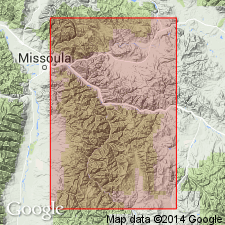
- Usage in publication:
-
- Garnet Range formation
- Modifications:
-
- Original reference
- Dominant lithology:
-
- Sandstone
- Quartzite
- Argillite
- AAPG geologic province:
-
- Northern Rocky Mountain region
Summary:
Pg. 681, figs. 2, 3. Garnet Range formation of Missoula group. Chiefly quartzites of different colors and types, but including some argillite and sandstone. Thickness 7,600 feet. Conformably underlies Sheep Mountain formation and overlies McNamara formation, all included in Missoula group. [Detailed section given.] Recognized in central western Montana, Missoula to Helena region. Age is pre-Cambrian (Belt).
Type locality: on north side of Blackfoot Canyon from Johnson Gulch, 2 mi east of Bonner, eastward to 1 mi from mouth of West Twin Creek, [Missoula Co., western MT]. Blackfoot Canyon forms northwest bdry of Garnet Range, the west part of which is composed largely of rocks of Garnet Range formation.
[Misprint (US geologic names lexicon, USGS Bull. 896, p. 802): date of publicatoin is 1931, not 1921.]
Source: US geologic names lexicon (USGS Bull. 896, p. 802).
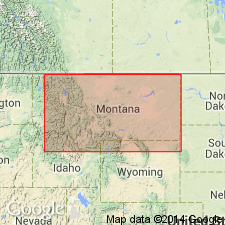
- Usage in publication:
-
- Garnet Range formation*
- Modifications:
-
- Areal extent
- AAPG geologic province:
-
- Northern Rocky Mountain region
Summary:
Sheet1. Garnet Range formation of Missoula group. Underlies Sheep Mountain quartzite and overlies McNamara formation, all in Missoula group. Age is Precambrian (Belt).
Source: Publication; US geologic names lexicon (USGS Bull. 1200, p. 1474).
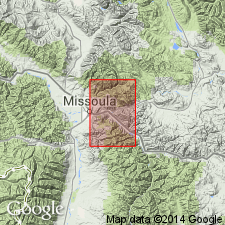
- Usage in publication:
-
- Garnet Range quartzite*
- Modifications:
-
- Revised
- Dominant lithology:
-
- Quartzite
- Argillite
- Shale
- AAPG geologic province:
-
- Northern Rocky Mountain region
Summary:
Pg. F195 (fig.), F204-F208, F217+; USGS Misc. Inv. Ser. Map I-296, 1959. Garnet Range quartzite of Missoula group. Chiefly greenish-gray quartzite interbedded with slightly lesser amounts of dark-green and dark-gray argillite, shale, and sandy argillite; weathers to a moderate to light brown. Stratigraphically restricted from Clapp and Deiss' definition; the upper massive coarse-grained pink-white cross-bedded pure siliceous quartzite is included in overlying Pilcher quartzite (new) of Missoula group, and the Cambrian(?) limestone and shale at head of Lime Kiln Creek are excluded. Thickness about 1,800 feet. (Clapp and Deiss measured a thickness of 7,600 feet in their section along Blackfoot River, across several faults and both limbs of the Wishard Creek syncline.) Overlies McNamara argillite (restricted) of Missoula group. Age is Precambrian (Belt).
Notable exposures in Wishard Creek syncline, in northeastern part of quadrangle, [Missoula Co., western MT].
Source: Publication; US geologic names lexicon (USGS Bull. 1200, p. 1474).
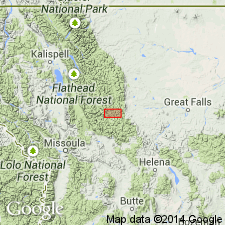
- Usage in publication:
-
- Garnet Range Formation
- Modifications:
-
- Reference
- AAPG geologic province:
-
- Northern Rocky Mountain region
Summary:
Name Missoula Group has been applied to all rocks in the Precambrian Belt Supergroup above the carbonate (Siyeh Formation of Glacier National Park or Helena Formation of Helena area). These same rocks were designated Camp Creek Series by Walcott in 1906, but that name has been little used and is abandoned in favor of Missoula in this report. The Camp Creek section is designated a reference section [but section not described] for the Missoula. The reference section is located along crest of the ridge parallel to and northwest of Camp Creek in secs 22, 28, and 33, T20N, R12W, Lewis and Clark Range, Powell Co, MT in Northern Rocky Mountain region where the following formations of the Missoula are exposed (ascending order): Snowslip, Shepard, and Shields Formations, Bonner Quartzite, McNamara and Garnet Range Formations. Geologic map.
Source: GNU records (USGS DDS-6; Denver GNULEX).
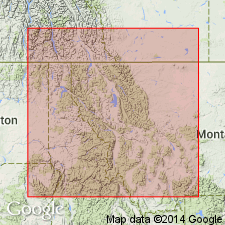
- Usage in publication:
-
- Garnet Range Formation*
- Modifications:
-
- Overview
- AAPG geologic province:
-
- Northern Rocky Mountain region
Summary:
Replaces use of Bouchard Formation (abandoned) in western MT. Is in Missoula Group of Precambrian Belt Supergroup. See figures 4, 5, 7 and 13 for correlation with Northern Rocky Mountain region of the U.S., and of the Purcell Supergroup of Alberta and British Columbia, Canada.
Source: GNU records (USGS DDS-6; Denver GNULEX).
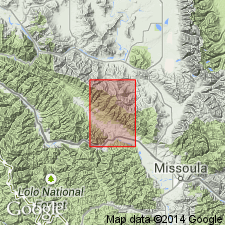
- Usage in publication:
-
- Garnet Range Formation*
- Modifications:
-
- Age modified
- AAPG geologic province:
-
- Northern Rocky Mountain region
Summary:
Is one of eleven formations of the Belt Supergroup mapped in report area. Age changed from Precambrian to Precambrian Y, the age term used for rocks that range in age from 1,600 to 800 m.y. old. About 8,200 ft thick. Lower contact with McNamara Formation of Belt sharp and conformable. Upper contact with Pilcher Quartzite of Belt is gradational through 50 ft of red and green beds that are mapped with Garnet Range. Mapped at south and southwest edge of quad in Mineral and Missoula Cos, MT in the Northern Rocky Mountain region.
Source: GNU records (USGS DDS-6; Denver GNULEX).
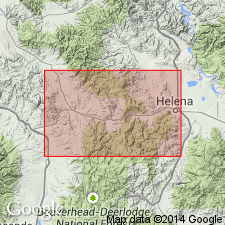
- Usage in publication:
-
- Garnet Range Formation*
- Modifications:
-
- Areal extent
- AAPG geologic province:
-
- Northern Rocky Mountain region
Summary:
The Garnet Range and Pilcher Formations, at the top of the Missoula Group are present 80 km west of the map area, but they were eroded from the map area Northern Rocky Mountain region prior to the deposition of the Middle Cambrian Flathead Quartzite. A minimum of 2,500 m of Middle Proterozoic rocks were eroded over a lateral distance of about 30 km. In report area, Flathead rests on the McNamara Formation of the Missoula Group.
Source: GNU records (USGS DDS-6; Denver GNULEX).
For more information, please contact Nancy Stamm, Geologic Names Committee Secretary.
Asterisk (*) indicates published by U.S. Geological Survey authors.
"No current usage" (†) implies that a name has been abandoned or has fallen into disuse. Former usage and, if known, replacement name given in parentheses ( ).
Slash (/) indicates name conflicts with nomenclatural guidelines (CSN, 1933; ACSN, 1961, 1970; NACSN, 1983, 2005, 2021). May be explained within brackets ([ ]).

